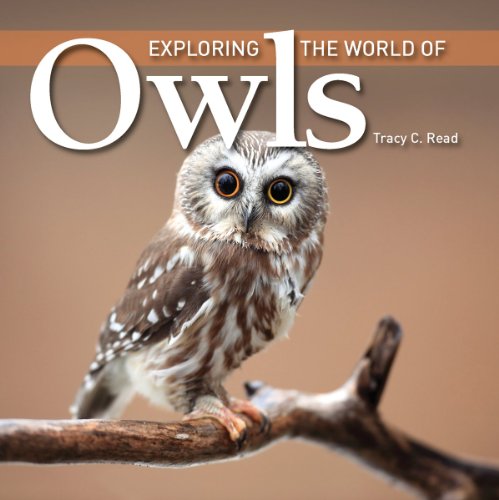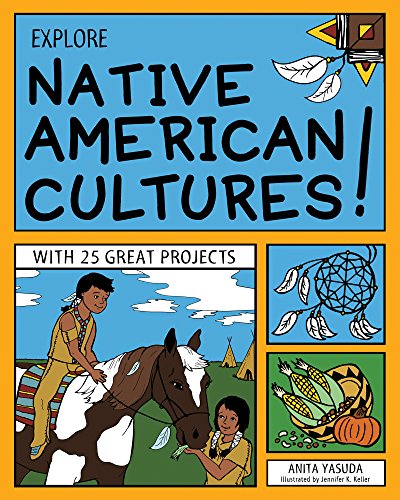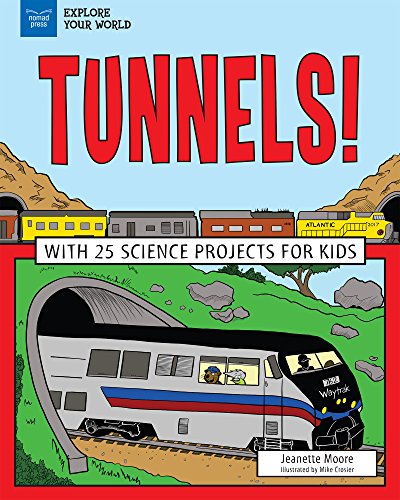-
Exploring the World of Owls
Tracy Read
Paperback (Firefly Books, Nov. 3, 2011)The haunting sound of its distant hoot may be as close as many of us ever get to an owl. But of the roughly 200 owl species worldwide, 19 make their homes across North America. These birds of prey display noticeable differences in size and markings, but they also share many physical traits and living skills. How do owls capture prey and defend themselves? How are their wings designed for silent, gliding flight? How do owls conceal themselves from predators? Young readers will learn the answers to these questions and much more in the beautifully illustrated Exploring the World of Owls. X
X
-
Explore Native American Cultures!: With 25 Great Projects
Anita Yasuda, Jennifer K Keller
Paperback (Nomad Press, Feb. 1, 2013)Explore Native American Cultures! with 25 Great Projects introduces readers to seven main Native American cultural regions, from the northeast woodlands to the Northwest tribes. It encourages readers to investigate the daily activitiesincluding the rituals, beliefs, and longstanding traditionsof America’s First People. Where did they live? How did they learn to survive and build thriving communities? This book also investigates the negative impact European explorers and settlers had on Native Americans, giving readers a glimpse into the complicated history of Native Americans.Readers will enjoy the fascinating stories about America’s First People as leaders, inventors, diplomats, and artists. To enrich the historical information, hands-on activities bring to life each region’s traditions, including region-specific festivals, technology, and art. Readers can learn Native American sign language and create a salt dough map of the Native American regions. Each project is outlined with clear step-by-step instructions and diagrams, and requires minimal adult supervision. M
M
-
Exploring the World of Foxes
Tracy Read
Paperback (Firefly Books, March 12, 2010)The facts and fun of life as a fox. With their catlike faces, big ears and fluffy tails, foxes appeal to youngsters, but children may not know that a fox can smell prey deep in the snow and that some can climb trees. Young readers will learn about the various fox species, such as red foxes, arctic foxes, gray foxes and swift foxes, and they will read about what it would be like to be a fox pup. Photographs of adult and young foxes in their natural habitats and sidebars with storylike content round out this rich portrayal of foxes in the wild. In the Exploring the World of ... series, Firefly Books is pleased to present an exciting new nature series produced especially for young readers who are eager to learn more about the wild animals they find especially appealing. The books are packed with facts and offer outstanding value. Clear text in large type and vivid photographs with explanatory captions describe the animals' physical attributes, and storylike narratives about their daily life -- where they live, what they eat, how they hunt, how they communicate, how they raise their young -- present a complete picture of each animal. T
T
-
Exploring the World of Raccoons
Tracy Read
Paperback (Firefly Books, March 11, 2010)A glimpse inside the daily life of nature's masked bandits. Children find the bandit-masked face and button nose of a raccoon irresistibly cute, and catching a glimpse of one in a neighborhood tree never fails to excite. Raccoons describes the natural history of these cousins of the panda bear and explains how that heritage helps them thrive in cities as well as in fields and woodlands. Color photographs of adults and kits in urban and natural settings give readers the chance to look more closely at these elusive creatures, and children will enjoy the amusing descriptions of the raccoon's antics and mischief. But Raccoons also shows youngsters why they shouldn't feed these brazen visitors and that, even though they share our cities and towns, raccoons will always be wild animals. In the Exploring the World of... series, Firefly Books is pleased to present an exciting new nature series produced especially for young readers who are eager to learn more about the wild animals they find especially appealing. The books are packed with facts and offer outstanding value. Clear text in large type and vivid photographs with explanatory captions describe the animals' physical attributes, and storylike narratives about their daily life -- where they live, what they eat, how they hunt, how they communicate, how they raise their young -- present a complete picture of each animal. S
S
-
Explore Atoms and Molecules!: With 25 Great Projects
Janet Slingerland, Matt Aucoin
Paperback (Nomad Press, April 11, 2017)Atoms and molecules are the basic building blocks of matter. Matter is every physical thing around us in the universe, including our own bodies! In Explore Atoms and Molecules! With 25 Great Projects, readers ages 7 to 10 investigate the structure of atoms and learn how atoms fit together to form molecules and materials.If everything is made out of atoms and molecules, why do people look different from dogs and doorknobs? In Explore Atoms and Molecules, readers discover that the characteristics of a material are determined by the way the atoms and molecules connect, and study how chemical reactions change these connections to create everything we know. This book discusses the elements on the periodic table and why they are grouped into families, encouraging the exploration of meaningful classification systems. States of matter and mixtures and compounds round out the exploration of atoms and molecules!This book supports the maker movement with lots of hands-on activities that illuminate the concepts of chemistry. Readers build 3-D models of molecules and create a periodic table guessing game. Fascinating sidebars offer opportunities for readers to connect the text with real-world science, and cartoon illustrations provide a fun foundation for learning. T
T
-
Explore Rocks and Minerals!: 20 Great Projects, Activities, Experiements
Cynthia Light Brown, Nick Brown, Bryan Stone
Paperback (Nomad Press, July 1, 2010)Explore Rocks and Minerals! offers kids ages 69 a fascinating introduction to geology. It investigates the geological forces that create and transform rocks, outlining the life cycle of igneous, sedimentary, and metamorphic rocks, and what they can tell us about the earth. It also explores fossils, and how they come to exist and are discovered.Explore Rocks and Minerals! includes 20 hands-on activities to bring learning to life. Kids create their own crystals, sculpt edible models of the planet, and bake volcanic meringue cookies. These easy-to- follow activities require minimal adult supervision and use common household products. By combining an interactive component with jokes, fun facts, and cartoons, Explore Rocks and Minerals! provides a fun, accessible introduction to geology. M
M
-
Explore Soil!: With 25 Great Projects
Kathleen M. Reilly
Paperback (Nomad Press, Sept. 15, 2015)Soil! We walk on it, play in it, build with it, grow our food in it, and get antibiotics from it. But what exactly is soil? What makes it so important? Can we survive without it? In Explore Soil! With 25 Great Projects, young readers learn how vital soil is to our lives. It filters the water we drink and the air we breathe, and most of the food we eat either grows in soil or subsists on plants that grow there. Soil is a very important part of our daily diet!Activities such as exploring soil runoff, composting, and analyzing soil composition offer kids the chance to get their hands dirty while coming face to face with the study of soil. Kids learn concepts within the fields of life science and chemistry while discovering the dangers soil faces. Explore Soil offers fun, practical information about something kids already love: soil! Q
Q
-
Exploring the World of Foxes
Tracy Read
Hardcover (Firefly Books, March 12, 2010)The facts and fun of life as a fox. With their catlike faces, big ears and fluffy tails, foxes appeal to youngsters, but children may not know that a fox can smell prey deep in the snow and that some can climb trees. Young readers will learn about the various fox species, such as red foxes, arctic foxes, gray foxes and swift foxes, and they will read about what it would be like to be a fox pup. Photographs of adult and young foxes in their natural habitats and sidebars with storylike content round out this rich portrayal of foxes in the wild. In the Exploring the World of ... series, Firefly Books is pleased to present an exciting new nature series produced especially for young readers who are eager to learn more about the wild animals they find especially appealing. The books are packed with facts and offer outstanding value. Clear text in large type and vivid photographs with explanatory captions describe the animals' physical attributes, and storylike narratives about their daily life -- where they live, what they eat, how they hunt, how they communicate, how they raise their young -- present a complete picture of each animal. S
S
-
Explore Forces and Motion!: With 25 Great Projects
Jennifer Swanson, Bryan Stone
Hardcover (Nomad Press, June 14, 2016)Everything moves! Kids run around the playground, cars drive on the road, and balls fly through the air. What causes all this motion? Physics! Forces and motion rule the way everything moves through space.In Explore Forces and Motion! With 25 Great Projects, readers ages 7 through 10 discover that the push and pull of every object on the planet and in space depends on how a force acts upon it. Things float because of a force called buoyancy, we stick to the ground because of a force called gravity, and we make footprints in sand because of a force called pressure.Physics becomes accessible and interactive through activities such as a experimenting with a water cup drop, building a bridge, and spotting magnetic field lines. Simple machines such as levers, pulleys, and wedges are used as vehicles for discovery and comprehension of the foundational concepts of physical science. Using a theme familiar to everyonemotionthis book captures the imagination and encourages young readers to push, pull, twist, turn, and spin their way to learning about forces and motion. Q
Q
-
Explore Colonial America!: 25 Great Projects, Activities, Experiments
Verna Fisher, Bryan Stone
Paperback (Nomad Press, Aug. 1, 2009)In Explore Colonial America!, kids ages 6-9 learn about America’s earliest days as European settlements, and how the colonists managed to survive, build thriving colonies, and eventually challenge England for independence.How did the colonists build homes, feed and clothe themselves, and get along with the Native Americans who were already here? This accessible introduction to the colonial period teaches young children about the daily lives of ordinary colonists and offers fascinating stories about those who helped shape the emerging nation. Activities range from creating a ship out of a bar of soap and building a log home out of graham crackers and pretzels to making a wampum necklace. Projects are easy-to-follow, require minimal adult supervision, and use primarily common household products and recycled supplies.By combining a hands-on element with riddles, jokes, fun facts, and comic cartoons, kids Explore Colonial America!, and have a great time discovering our nation’s founding years. M
M
-
Skyscrapers!: With 25 Science Projects for Kids
Elizabeth Schmermund, Mike Crosier
Hardcover (Nomad Press, Aug. 1, 2018)Look up, up, up! How do skyscrapers get so tall? Skyscrapers are amazing feats of engineering that kids (and adults!) find fascinating. How do they get so high? How do they stay standing? Who is involved in designing and building these gravity-defying structures? In Skyscrapers! With 25 Science Projects for Kids, elementary-aged kids learn about the principles of engineering that are used in building skyscrapers, as well as the history of skyscrapers themselves. Readers also explore the kinds of professionals that contribute to the raising of a skyscraper, from engineers to architects to constructions teams. To answer the burning question on every young engineer’s mind―how do skyscrapers stay standing?―readers discover the important designs used to build tall buildings, including the tube frame, the bundled tube frame, and x-bracing. And by following the evolution of skyscraper design, STEAM-focused students learn how structures have become more stable and more complex through the introduction of design elements and new materials. STEAM projects for kids, including experiments with earthquake-resistant materials, testing the relative strength of different shapes, and discovering the effect of vibration on structures, offer a unique, interactive learning experience, while links to primary sources offer ample opportunity for further student-led exploration. Fun facts, engaging illustrations, timeline, glossary, and resources keep kids wanting to learn more about engineering design. Skyscrapers! is part of a set of four Explore Engineering books. In the Explore Engineering set, readers ages 7 to 10 learn the physics behind the things they build: Why does a tower of blocks eventually fall? Why does a tunnel sometimes cave in? Through a series of focused, science-minded activities that require critical thinking paired with creative trial-and-error attempts at building, readers develop foundational understanding of the physics that guides the building and maintenance of bridges, canals, tunnels, and skyscrapers.Titles in the Explore Engineering set include Bridges! With 25 Science Projects for Kids; Canals and Dams! With 25 Science Projects for Kids; Tunnels! With 25 Science Projects for Kids; and Skyscrapers! With 25 Science Projects for Kids. Nomad Press books in the Explore Your World series for children ages 7–10 integrate content with participation. Common Core State Standards, the Next Generation Science Standards, and STEM Education all place project-based learning as key building blocks in education. Combining content with inquiry-based projects stimulates learning and makes it active and alive. Nomad’s unique approach simultaneously grounds kids in factual knowledge while allowing them the space to be curious, creative, and critical thinkers. R
R
-
Tunnels!: With 25 Science Projects for Kids
Jeanette Moore, Mike Crosier
Hardcover (Nomad Press, Aug. 1, 2018)Moles, beavers, rabbits . . . these animals burrow tunnels in the ground every day! What other kind of creature makes tunnels? Humans! In Tunnels! With 25 Science Projects for Kids, kids ages 7 to 10 explore the fascinating world of passageways beneath the ground, dug deep within the earth through soil and rock. But why dig through rock to make a tunnel? Tunnels give people a way to travel and transport goods from one place to another. Readers learn about the engineering and construction that goes into every tunnel made, whether it’s being dug under roads, under oceans, or under cities. Kids form a foundational learning about the laws of physics that govern our world and discover how engineers use these laws to design tunnels that withstand the test of time, weight, and earthquakes. Controlling groundwater, drilling through rocks, and removing earth are just a few tasks workers must face. STEM projects for kids, including creating a tunnel maze, designing a series of tunnels on graph paper, and experimenting with Newton’s laws of motion, offer a unique, interactive learning experience, while links to primary sources offer ample opportunity for further student-led exploration. Fun facts, engaging illustrations, timeline, glossary, and resources keep kids wanting to learn more about the engineering design process. Tunnels! is part of a set of four Explore Engineering books. In the Explore Engineering set, readers ages 7 to 10 learn the physics behind the things they build: Why does a tower of blocks eventually fall? Why does a tunnel sometimes cave in? Through a series of focused, science-minded activities that require critical thinking paired with creative trial-and-error attempts at building, readers develop foundational understanding of the physics that guides the building and maintenance of bridges, canals, dams, tunnels, and skyscrapers. Titles in the Explore Engineering set include Bridges! With 25 Science Projects for Kids;Canals and Dams! With 25 Science Projects for Kids; Tunnels! With 25 Science Projects for Kids; and Skyscrapers! With 25 Science Projects for Kids. Nomad Press books in the Explore Your World series for children ages 7–10 integrate content with participation. Common Core State Standards, the Next Generation Science Standards, and STEM Education all place project-based learning as key building blocks in education. Combining content with inquiry-based projects stimulates learning and makes it active and alive. Nomad’s unique approach simultaneously grounds kids in factual knowledge while allowing them the space to be curious, creative, and critical thinkers. R
R